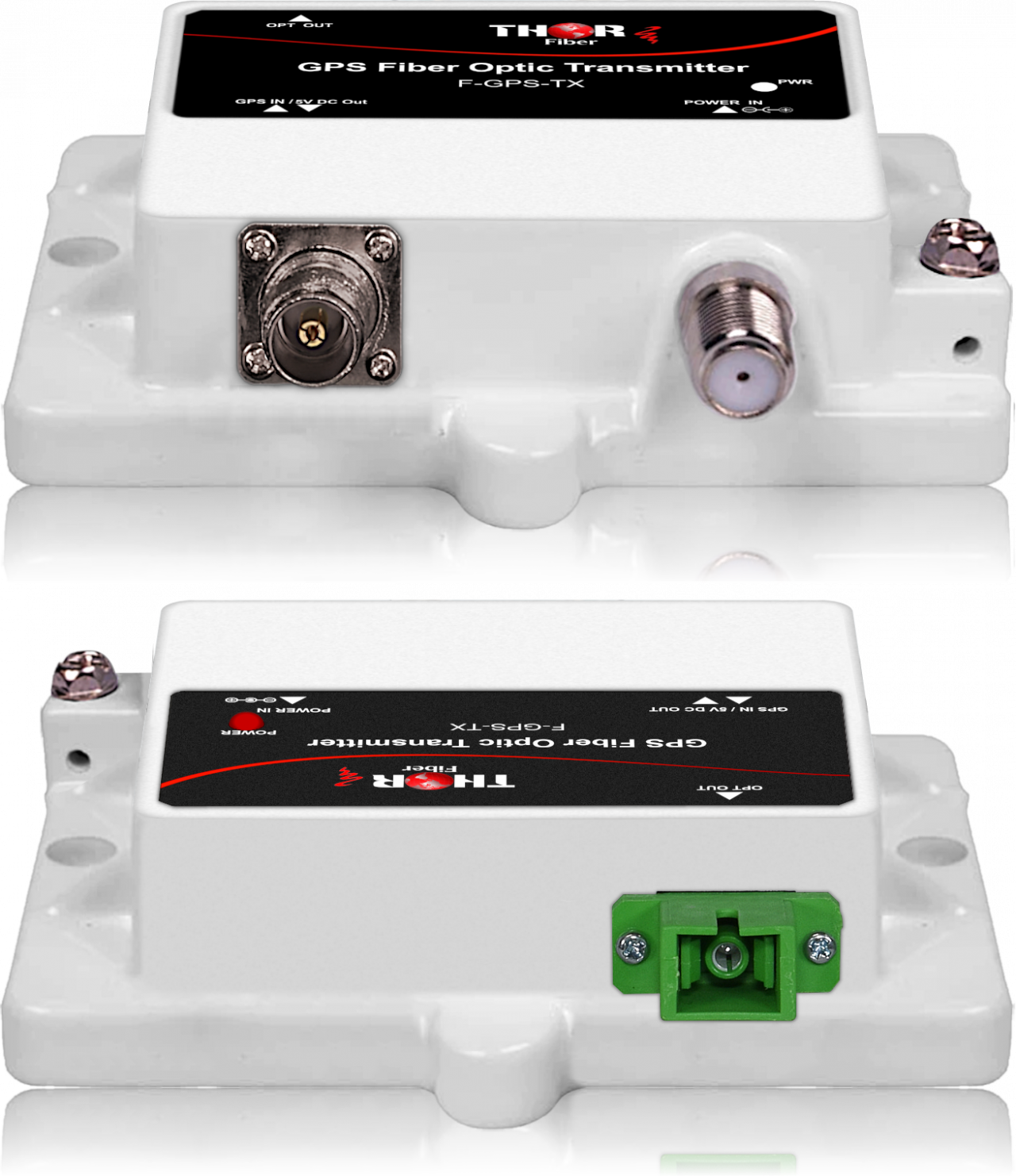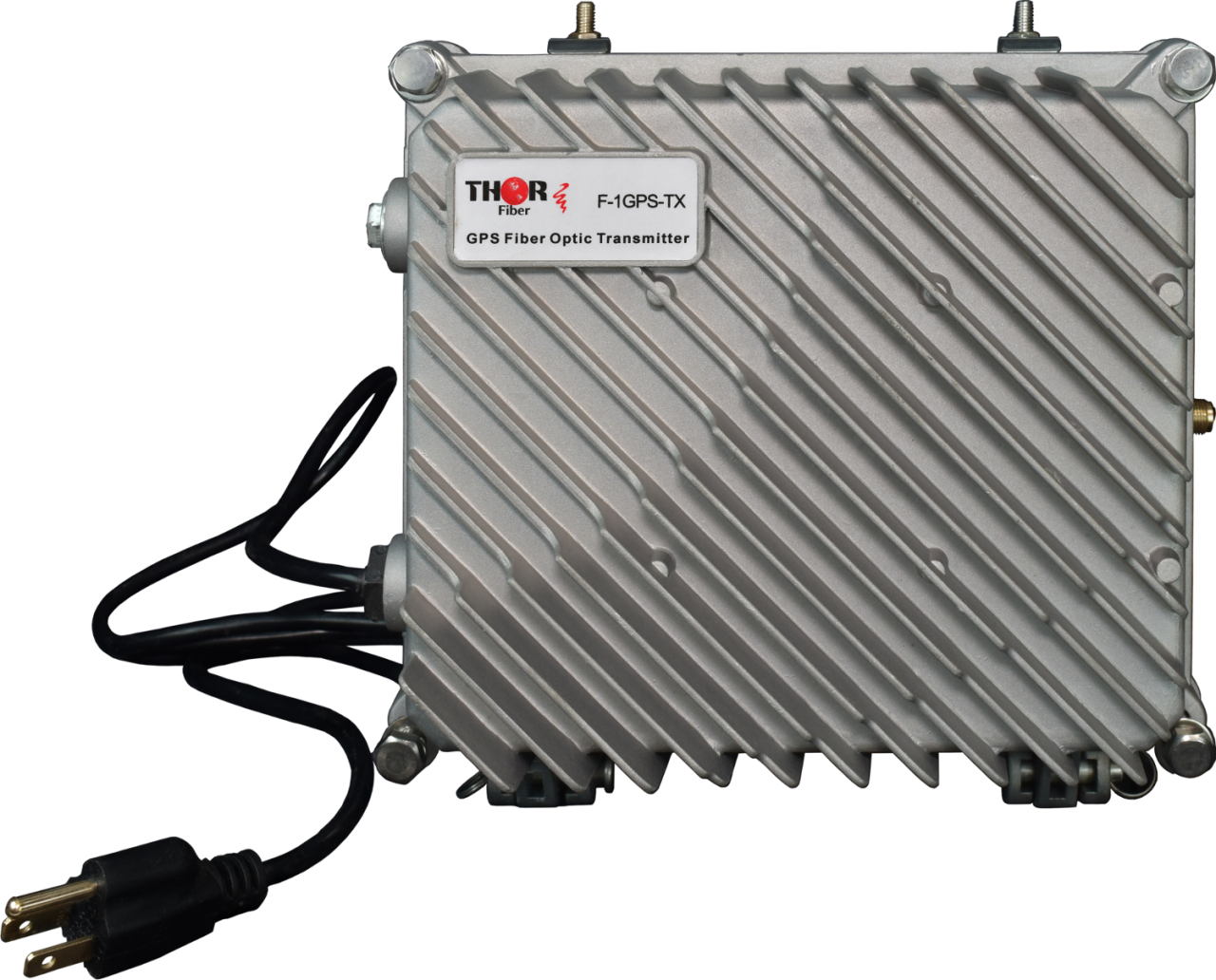Best GPS over Fiber Optic Equipment
GPS and Fiber basic information
The Global Positioning System (GPS), officially NAVSTAR GPS, is a global navigation satellite system for positioning. It was developed by the US Department of Defense since the 1970s and replaced from about 1985, the old satellite navigation system NNSS (Transit) of the US Navy, as well as the Vela satellites for the detection of nuclear weapon explosions. GPS has been fully operational since the mid-1990s, and has allowed civilian users to achieve accuracy levels well beyond 10 meters since the shutdown of Artificial Selective Availability (2 May 2000). Accuracy can be increased to centimeter-range or better by using differential methods (differential GPS / DGPS) around a reference receiver. The satellite-based Enhancement Systems (SBAS), which distribute correction data over geostationary satellites that are not receivable in the Polar Regions and also belong to the class of DGPS systems, achieve continent-wide accuracies of one meter. GPS has established itself as the world's most important location method and is widely used in navigation systems.
For technical reasons, the accuracy of calculating altitude is about 3 times lower than latitude and longitude. This is due to the geometry of the spatial notch used to determine the position. The quality of position specifying is determined by DOP (Dilution Of Precision) precision blur parameters.
GPS receivers have many functions, including:
- determination of coordinates according to different coordinate systems (standard WGS 84);
- logging of the trace;
- "to point" and "route" navigation;
- track back (i.e. return to the place of departure "same route");
- distance measurement;
- determination of area (e.g. plot);
- calculating the moments of sunrise and sunset and the phases of the moon.
And in more extensive receivers:
- map display and navigation on layered maps;
- communication via serial port (RS232 / USB) and Bluetooth with other electronic equipment (PC, PPC, Palm, electronic sea chart ECDIS);
- auto routing (setting the automatic route "on the roads").
For simultaneous reception of a signal from several satellites or a two-frequency signal from one satellite, receivers of two types are used:
- Multi-channel - these receivers consist of a defined number of independent channels and each of them is adapted to receive and process signals from one satellite. Signal reception and processing processes are carried out in such a multi-channel receiver at the same time. Observations can be made with a second frequency;
- Multi-plexing - these receivers consist of one or more channels, each of which can receive individual signals from satellites. Observations are made with a millisecond frequency. The best quality signal is provided by the multi-channel correlation type receivers. Squaring type receivers square both signals and noise.
The scope and method of operation, the multiplicity and versatility of applications, reliability and usefulness in everyday life cause that devices using GPS are really, commonly used, often in a very unconventional way, and the new positioning systems that are already in the implementation phase, with even greater capabilities make devices to support and service the GPS systems very popular and widely used. Among the key suppliers of supplementary equipment there is - of course - Thor Broadcast with their interesting proposals.
Best GPS over Fiber Optic Equipment:
This device is used for transporting Cellular GSM, PCS or CDMA RF carrier signals for long distances over fiber optic cables. These units are most commonly used to connect cellular base stations to microcells. It can transport up to 50 miles over singlemode fiber optic cable.

Features
- AGC function to realize auto gain compensation for optical transmission.
- Transparent data transmission channel for data exchange.
- Wide-band features for multi-system work.
- Perfect optical and RF features.
- Applications
- GSM optical repeater GSM optical repeater ,GSM over fiber
- DAS, WiMax, Satcom, LTE
- CDMA optical repeater ,CDMA over fiber
- WCDMA optical repeater, WCDMA over fiber
- RF over fibre for cellular coverage.
- Cell phone and 2-way radio over fiber
- Radio over fiber
Highlights
- Simplicity for indoor coverage
- Easy for 6-carrier design
- Better noise performance to reduce affect to BTS
- Convenient management
- Easy to use
IMPORTANT NOTE*** (it is very important to interface our unit with SC/APC - Angle Polished Connector to avoid any light reflections.
If your fiber is terminated with the SC, ST, FC /PC flat connector, you need to use an optical jumper from PC type to SC/APC for proper conversion.
This device is a transmitter and receiver pair used to transmit the RF Carrier signal from a GPS antenna to a remote location up to 10 Km. This unit is useful for feeding GPS equipment that is far away from a line of sight location, or where a local antenna is not convenient

Features
- Extends the range between GPS antennas and equipment to over 20 miles
- Provides up to 4 redundant GPS links for highly reliable systems
- Fiber links are immune to RF interference problems associated with coax
- Ideal for broadcasting towers, cell sites, military installations, and large ships
- Dual redundant power supplies can be ordered for either AC or DC power
- Provides a fiber security break and insulates from lightning strikes
- GPS base stations with long antenna cable runs
- Run the GPS carrier to multiple GPS timing boards throughout a company
- Run GPS throughout an aircraft
- Satisfies the requirement of supplying multiple GPS receivers with a carrier, spread over a great distance
- For R&D facilities, supplies a GPS carrier to a multitude of engineers and technicians with only one antenna on the roof.
- DAS, WiMax, Satcom, LTE
IMPORTANT NOTE*** (it is very important to interface our unit with SC/APC - Angle Polished Connector to avoid any light reflections.
If your fiber is terminated with the SC, ST, FC /PC flat connector, you need to use an optical jumper from PC type to SC/APC for proper conversion.
This device is a transmitter and receiver pair used to transmit the RF Carrier signal from a GPS antenna to a remote location up to 10 Km. This unit is equipped with an outdoor waterproof Transmitter and rack mountable Receiver with redundant power supply

Features
- Supports all GPS frequencies internationally
- 4 independent redundant GPS inputs
- 4 Independent fiber optic output
- Redundant power supply
- LCD panel with all diagnostic information about RF and optical levels.
- NEMA 4 Fiber Transmitter for outdoor mounting
- Compact Transmitter also mounts indoors without using rack space
- Each system supports one or two GPS antenna paths
- Supports high level of optical split and RF split for flexible routing of GPS for small cells and extended base station sites
- Operates on backed up base station power or dual AC power supplies
- Simple to install – no adjustment
- Minimal signal loss and degradation over very long cable runs up to 20km.
- Provides a highly secure tamper-proof GPS over fiber connection between antenna and receiver.
- Interference free link through noisy environments, the optical signal is unaffected by electrical noise.
- Lower cost of optical fibre cable compared with long cable runs of high quality low-loss coax.
- Electrical isolation between antenna and receiver protects against lightning strikes and electrical surge
- Minimal signal loss and degradation over very long cable runs up to 20km.
- Provides a highly secure tamper-proof GPS over fiber connection between antenna and receiver.
- Interference free link through noisy environments, the optical signal is unaffected by electrical noise.
- Flexible, small-diameter, lightweight optical fiber cable for GPS over fiber.
- Lower cost of optical fibre cable compared with long cable runs of high quality low-loss coax.
- Electrical isolation between antenna and receiver protects against lightning strikes and electrical surge
IMPORTANT NOTE*** (it is very important to interface our unit with SC/APC - Angle Polished Connector to avoid any light reflections.
If your fiber is terminated with the SC, ST, FC /PC flat connector, you need to use an optical jumper from PC type to SC/APC for proper conversion.
This device sends GPS signal from the antenna to the receiver over singlemode fiber with SC/APC connectors up to 20Km

Features
- Supports all GPS frequencies internationally
- Supports L1 at 1575.42 MHz, L2 at 1227.60 MHz, L3 at 1381.05Mhz , L4 at 1379.913Mhz and L5 at 1176.45 MHz, L6 at 1278.75Mhz, L7 at 1267.6Mhz GPS bands
- Extends the range between GPS antennas and equipment to over 20 miles
- Fiber links are immune to RF interference problems associated with coax
- Ideal for broadcasting towers, cell sites, military installations, and large ships
- Provides a fiber security break and insulates from lightning strikes
- 1 GPS input
- 1 Independent fiber optic ouput SC/APC
- N Female Type RF Connetor
- Portable power supply
- Supports high level of optical split and RF split for flexible routing of GPS for small cells and extended base station sites
- Simple to install – no adjustment
- Minimal signal loss and degradation over very long cable runs upto 20km.
- Provides a highly secure tamper-proof GPS over fiberconnection between antenna and receiver.
- Interference free link through noisy environments, the optical signal is unaffected by electical noise.
- Electrical isolation between antenna and recever protects against lightning strikes and electrical surge
- Selectable GPS antenna powering voltage
- Supports all L2 & L1& L5 GPS bands
- The transmitter receiver Kit comes with 110-220V AC to DC power supply
- GPS base stations with long antenna cable runs
- Run the GPS carrier to multiple GPS timing boards throughout a company
- Run GPS throughout an aircraft
- Satisfies the requirement of supplying multiple GPS receivers with a carrier, spread over a great distance
- For R&D facilities, supplies a GPS carrier to a multitude of engineers and technicians with only one antenna on the roof.
- DAS, WiMax, Satcom, LTE over fiber
IMPORTANT NOTE*** (it is very important to interface our unit with SC/APC - Angle Polished Connector to avoid any light reflections.
If your fiber is terminated with the SC, ST, FC /PC flat connector, you need to use an optical jumper from PC type to SC/APC for proper conversion.
The L signals are different frequency bands used by the GPS (Global Positioning System) satellites to transmit signals to GPS receivers. These frequencies are part of the evolution of GPS technology, providing higher accuracy, better reliability, and more advanced features, especially with the modernization of GPS.
Here are the key L bands for GPS and their corresponding frequencies:
1. L1
- Frequency: 1575.42 MHz
- Description: The L1 frequency is the most commonly used frequency for civilian GPS receivers. It carries the C/A (Coarse/Acquisition) code and the P(Y) code (for military use).
2. L2
- Frequency: 1227.60 MHz
- Description: L2 is mainly used for military applications but can also be used for civilian applications, particularly in high-accuracy GNSS systems with dual-frequency receivers. It carries the P(Y) code and the L2C code for civilian use.
3. L3
- Frequency: 1381.05 MHz
- Description: L3 is used primarily for nuclear detonation detection and is not used for standard GPS navigation.
4. L4
- Frequency: 1379.913 MHz
- Description: L4 is used primarily for the ionospheric calibration and research purposes. It is part of the GPS III modernization but has not yet been widely used for navigation.
5. L5
- Frequency: 1176.45 MHz
- Description: L5 is a high-precision, safety-of-life signal for both civilian and professional applications. It offers improved accuracy and is used for critical applications such as aviation. L5 is a new signal available from GPS III satellites.
6. L6
- Frequency: 1278.75 MHz
- Description: L6 is used primarily for commercial purposes and is part of the GPS III modernization. This signal is intended for high-accuracy applications and is used by the GPS III satellites to provide improved performance.
7. L7
- Frequency: 1267.6 MHz
- Description: L7 is part of the GPS III modernization program and is intended for both military and civilian use, contributing to a more robust and accurate GPS system.
Summary of GPS L Bands and Corresponding Frequencies:
| Signal |
Frequency (MHz) |
Description |
| L1 |
1575.42 |
Civilian (C/A code), Military (P(Y) code) |
| L2 |
1227.60 |
Military (P(Y) code), Civilian (L2C code) |
| L3 |
1381.05 |
Nuclear Detonation Detection (Not used for navigation) |
| L4 |
1379.913 |
Ionospheric Research (Limited Use) |
| L5 |
1176.45 |
Civilian Safety-of-Life (Aviation) |
| L6 |
1278.75 |
Commercial Use (GPS III) |
| L7 |
1267.6 |
Modernized GPS III Signal |
These frequencies ensure that GPS signals can be used effectively in various applications, from consumer navigation to precise scientific and military purposes. The modernized signals like L5, L6, and L7 are designed to offer enhanced performance in terms of accuracy, reliability, and resistance to interference.
This device is Waterproof Outdoor GPS fiber optic Transmitter and 19" rack mountable receiver. This unit sends the signal from a GPS antenna to a receiver over single mode fiber up to 50km.

Features
- Supports L1 at 1575.42 MHz, L2 at 1227.60 MHz, L3 at 1381.05Mhz , L4 at 1379.913Mhz and L5 at 1176.45 MHz, L6 at 1278.75Mhz, L7 at 1267.6Mhz GPS bands
- Waterproof Transmitter - NEMA 4 Fiber Transmitter for outdoor weather enclosure
- 19" rack mountable receiver
- 50 ohm N type RF connector or TNC by request
- +5V DC to the GPS antena
- Dual power supplies
- Optical meter built in
- RF meter built in
- RS232 communication and setup
- SC/APC fiber connectors
- Transmitter supports up to 32 Receivers
- Transmits all common GPS, GALILEO and GLONASS bands
- L1 and L2 GPS frequencies
- Link operation 1m to 50km
- >50km systems also available
- GPS antenna powering and monitoring
- DAS, WiMax, Satcom, LTE
- Time server load input/spoofing
- Simple plug and play
- Fiber-Span replacement product
- Thor Fiber standard 5 year warranty included
GPS-over-Fiber Applications:
- Cell towers,
- Cellular Base Station Equipment
- Shelters
- Aircraft
- SATCOM
- Vehicles
- Naval
- Bunkers
- Subways
- Undeground Parking Stuctures,
- Tunnels
- Submarines
- Aerospace and Defense
- Mines and Mining
- Driling Ocean Towers
- Underwater Stuctures
IMPORTANT NOTE*** (it is very important to interface our unit with SC/APC - Angle Polished Connector to avoid any light reflections.
If your fiber is terminated with the SC, ST, FC /PC flat connector, you need to use an optical jumper from PC type to SC/APC for proper conversion.

 ES
ES






